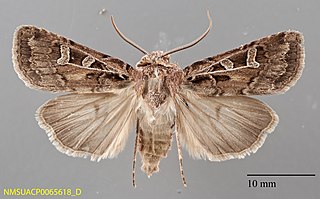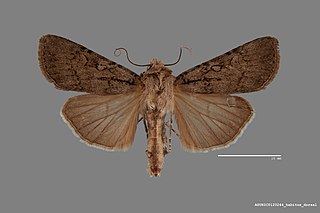Related Research Articles

Euxoa is a genus of moths of the family Noctuidae.

Euxoa tronellus is a moth of the family Noctuidae first described by Smith in 1903. It is found in western North America from western North Dakota and South Dakota, west across southern Saskatchewan and southeastern Alberta to Washington, south to southern California and northern New Mexico.

Euxoa medialis, the median-banded dart, is a moth of the family Noctuidae. The species was first described by Smith in 1888. It is found in North America from southern Manitoba and central Wisconsin, west to southwest Alberta and California; north to southern Alberta and south to south-central Mexico.
Euxoa catenula is a species of moth of the family Noctuidae first described by Augustus Radcliffe Grote in 1879. It is found in North America from southern Saskatchewan west to southern Vancouver Island, south to Kansas, New Mexico, Arizona and southern California.
Euxoa mimallonis is a species of moth of the family Noctuidae first described by Smith in 1890. It is found in North America from Nova Scotia west to coastal British Columbia, south in the east to Michigan and Minnesota, in the west to central California and New Mexico.
Euxoa siccata is a species of moth of the family Noctuidae first described by Smith in 1893. It is found in North America, including Alberta and Colorado.
Euxoa bochus is a moth of the family Noctuidae first described by Herbert Knowles Morrison in 1874. It is found in western North America, from Vancouver Island, south to southern Utah and northern New Mexico, east to central Colorado, Wyoming and the Cypress Hills area of south-western Saskatchewan. It is also present in Manitoba and British Columbia.
Euxoa declarata, the clear dart, is a moth of the family Noctuidae. The species was first described by Francis Walker in 1865. It is found in Canada in Ontario, Quebec, New Brunswick, Nova Scotia, Prince Edward Island, British Columbia, Alberta, Saskatchewan, Yukon and Manitoba. It is found as far west as central Alaska. In the United States it is also found to Minnesota and North Carolina in the east and Arizona, New Mexico and California in the west.

Euxoa detersa, the rubbed dart, sandhill cutworm or sand cutworm, is a moth of the family Noctuidae. The species was first described by Francis Walker in 1856. It is found in North America from Newfoundland to North Carolina, west to Nebraska, north to Alberta and the Northwest Territories.

Euxoa divergens, the divergent dart, is a moth of the family Noctuidae. The species was first described by Francis Walker in 1857. It is found in North America from Newfoundland to Alaska, south to New York and Michigan in the east, and in the mountains of the west, south to New Mexico, Arizona and California.
Euxoa aequalis is a moth of the family Noctuidae first described by Leon F. Harvey in 1876. It is found in Canada from British Columbia, Alberta, Saskatchewan and Yukon, south into the United States, where it has been recorded from Colorado, Wyoming and California.
Euxoa atomaris is a moth of the family Noctuidae first described by Smith in 1890. It is found in North America from North Dakota, southern Alberta and British Columbia, south to central New Mexico, Arizona and southern California.
Euxoa auripennis is a moth of the family Noctuidae first described by J. Donald Lafontaine in 1974. It is found in western North America from eastern North Dakota and south-western Manitoba west to central British Columbia, south to southern California and Colorado.
Euxoa aurulenta, the dune cutworm, is a moth of the family Noctuidae. The species was first described by Smith in 1888. It is found in North America from Ontario west to Alberta and Washington, south to Illinois, Nebraska, Colorado and Arizona.

Euxoa choris is a moth of the family Noctuidae first described by Leon F. Harvey in 1876. It is found in North America from south-western Saskatchewan, central Alberta and south-central Yukon, south to New Mexico, Arizona and California.

Euxoa citricolor is a moth of the family Noctuidae first described by Augustus Radcliffe Grote in 1880. It is found in North America from eastern South Dakota and western North Dakota, northwest to southern Alberta, west to western Washington and south and east to southern California, New Mexico and Colorado.
Euxoa clausa is a moth of the family Noctuidae first described by James Halliday McDunnough in 1923. It is known in North America mainly from the north-western Great Plains in southern Saskatchewan and Alberta, south to south-western Montana and Nebraska.
Euxoa comosa, the hairy euxoa moth, is a moth of the family Noctuidae first described by Herbert Knowles Morrison in 1876. It is found in western North America, except the Pacific coast, ranging east through the northern Great Plains, and in the Hudsonian zone to the Atlantic Ocean. It is found in every province and territory of Canada, except Nunavut.
Euxoa dargo is a moth of the family Noctuidae first described by Strecker in 1898. It is found in North America from south-eastern Manitoba west to the southern interior of British Columbia, south to Oregon, southern Idaho and northern New Mexico, and east to eastern South Dakota.
Euxoa edictalis is a moth of the family Noctuidae first described by Smith in 1893. It is found in North America from south central Alberta and east-central Montana, west to south-central British Columbia, south to central California, southern Nevada, central Utah and western Colorado.
References
- "Species Details Euxoa brevipennis". University of Alberta Museums. E.H. Strickland Entomological Museum. Retrieved November 16, 2020.
- "933438.00 – 10824 – Euxoa brevipennis – (Smith, 1888)". North American Moth Photographers Group. Mississippi State University. Retrieved November 16, 2020.